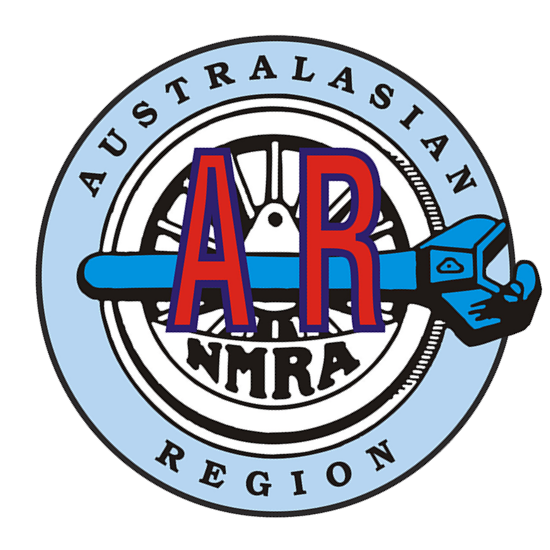Steve Magee – On30
Layout:
Scale: On30Size: 7m x 4mType: Point-to-pointTheme: Logging in US Pacific north-west, 1930(ish)Control: NCE DCCConstruction: L-girder benchwork, foam modular yard base, Pyneboard trackbase on mainTrackwork: Peco On16.5 on Abelflex foamHeight: 120 cm to 180 cm
Room:
Garden shed, one single door, window with internal shutters for light control. Room is lined with Villaboard and is air conditioned and heated. Serves as train-themed home theatre with ceiling mounted projector and surround sound. Overhead room lighting controlled by dimmers.
Presentation:
Layout is designed to be a layout room, rather than a room with a layout in it. Valences are ceiling mounted with a depth of 45 cm, reducing in height over double deck area. 25 energy-saving lamps mounted behind the valence, output varying dependent on placement and distance above the layout. Layout fascia panels around the layout, sloped away from inside the room with a 5 cm ledge to act as an arm-rest to protect scenery details. All wiring buses and connections are made behind the panel, rather than under the layout. Ceiling, valence, fascia and panels all painted dark purple/grey (Dulux Rameau) in satin enamel, to give the layout a shadow box effect.
Track:
Peco Streamline On16.5 track and points. Track is laid directly onto either a foam or softboard base in yard and station area, and on the main onto Abelflex 12 (or is it 15?) mm foam concrete expansion strip in varying widths depending on single- or double-track use. Track is glued to base with Bondall’s Bondcrete, and ballasted with Chucks Ballast glued in place with diluted Bondcrete. I use Bondcrete as it dries flat, and also retains a little give so the track on its foam roadbed can still be depressed with finger pressure for noise control, even when fully ballasted.
Wiring:
I hate wiring, so it was designed to make it easy for me to work on, rather than trying to solder while hanging on, bat-like, upside down under the benchwork. Four buses are located behind the sloping fascia – cab bus, main track bus, accessory bus and 16v AC bus. Anything wired into the layout – points, track feeds etc – are prewired onto the component then fed to the space behind the fascia with long tag ends. All connections, stationary decoders and terminal blocks are located here and it is where all connections are made. Standing up or seated, Comfortably. In good light. Where my multi-focals (and me) are not confused.
Scenery:
Ground scenery is a web of cardboard strips, hot glued and/or stapled. A layer of torn newspaper, each piece approximately 15 cm x 10 cm is layed and overlapped on the web then soaked with a mist bottle which has Bondcrete and water (1 part adhesive, 9 parts water) is sprayed onto the newspaper until it settles onto the web. Given a day to dry, it forms a semi-impermeable surface for the plaster dipped hand towels that follow, greatly reducing the amount of plaster drip. Once the plaster-dipped towels are in place and dry, they are sprayed with the misty water/glue mix until it runs off the surface, when are a second layer of thick(ish) plaster is trowelled onto it to a depth of about 10 mm. When this layer attains a clay-like consistency, plastic putty knives (cheap from Bunnings) are used to hack a rock surface into it – basically, carve away any that doesn’t look like rock. Lightly brush the surface with an old stiff brush, spray an india ink/water mix (about 5 drops of ink to 500 ml of water) to settle into and give depth to nooks and crannies.
Colouring is a light, rock coloured house paint diluted 2 to 1. with a spray bottle containing the india ink and another one with just water. Use a 35 or 50 mm brush, smear a streak of paint onto the plaster. Immediately spray with both mist bottles, alternately, until it looks rock(ish). Finish with whatever scenic material you prefer, I use Woodland Scenics, with sifted packing sand for texture.
Structures:
Still thin on the ground, have to get ahead here. Mostly either kit (water tower, backwoods repair shed) or scratchbuilt (trestle, engine shed, buildings in engine service area) or kit-bashed (coaling tower, turntables). Personnel are also scarce but the Tamiya 1/48 scale military figures, esp a German Field Service crew will hopefully soon start filling the gaps.
Operation:
Still researching this area, but it (the layout) was designed for operation from the start. Turns consist of empty log cars from the log pond to the switchback by mallet (it also has to run smokebox leading up the 1 in 12 Devils Pinch, where it exchanges empties for loads from the falling area brought to Halfway by a geared loco, prior to returning back to Halfway, running around the train then taking the loaded cars back to Swamilla. The geared locos finish the run up t the falling area from Switchback, returning there with loaded cars to await the next Mallet run.There are also equipment turns to the falling area (crew, supplies etc), removal of finished lumber from the sawmill, equipment to the sawmill and a small passenger service from RestOfWorld (fiddle yard/programming track). So hopefully the layout is more than a scening diorama with movement.
